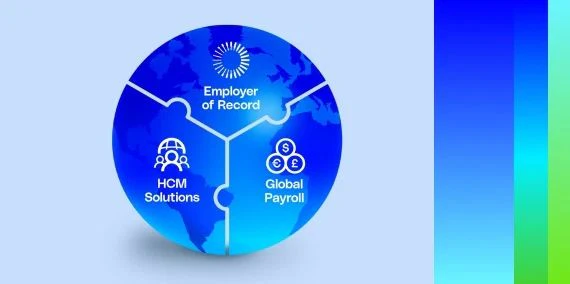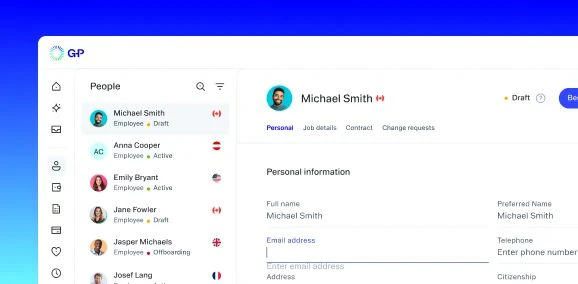Managing payroll in Lithuania requires a comprehensive understanding of the country’s tax, social security, and employment regulations. For companies expanding into the region, navigating these complexities is crucial for maintaining compliance. As a global Employer of Record, G-P simplifies global expansion by managing all aspects of Lithuanian payroll and HR.
Partner with us to manage your Lithuanian payroll while you focus on your business goals. We handle the intricacies of local employment compliance laws, mitigating risk and ensuring your employees are paid accurately and on time.
Tax and social security in Lithuania
Employers must accurately calculate and withhold taxes and social security contributions from employee salaries. As of 2025, the key obligations are as follows:
Personal income tax
Lithuania has a progressive personal income tax system:
- A 20% tax rate applies to annual income up to a specific threshold (approximately EUR 126,532 for 2025, which is 60 times the national average wage).
- A 32% Tax Rate: This higher rate is applied only to the portion of annual employment income that exceeds EUR 126,532.
A basic tax-exempt amount (NPD) is available, primarily benefiting employees with lower incomes. The NPD amount is calculated based on the employee’s total income and reduces their taxable base.
Social security contributions (Sodra)
Both employees and employers contribute to the state social insurance fund, known as Sodra. These contributions cover pensions, health insurance, sickness, maternity, and unemployment benefits.
- Employee contribution: The standard rate is 19.5% of the employee’s gross salary. Employees may also opt into a supplementary pension plan, which increases their contribution (typically by 3%).
- Employer contribution: The standard rate is 1.77%. This includes 1.45% for general social insurance, 0.16% for the Long-Term Employment Fund, and 0.16% for the Guarantee Fund. The rate may vary slightly depending on the company’s occupational accident risk category.
An annual ceiling applies to social security contributions, which is aligned with the 60 national average wage threshold used for PIT.
Key aspects of payroll administration
Payroll cycle and payslips
According to the Labour Code, salaries must be paid at least once per month, though twice-monthly payments can be agreed upon in the employment contract. Employers are legally required to provide each employee with a detailed payslip for every pay period, either electronically or on paper. The payslip must clearly itemize gross earnings, hours worked, all deductions (taxes and social security), and the net amount paid.
Termination and final pay
Managing termination correctly is critical for payroll. For termination at the employer’s discretion without fault, the statutory notice period is 1 month. This notice period is doubled for certain employees, such as those within 5 years of retirement age.
Severance pay is mandatory for termination without employee fault:
- 0.5 month’s average salary for employees with less than one year of service.
- 2 months’ average salary for employees with one or more years of service.
All final payments, including outstanding salary and severance, must be settled on the employee’s last day of work.
Lithuania payroll options for companies
Companies expanding to Lithuania have three primary payroll options:
- Internal payroll: Companies with a long-term commitment and a registered subsidiary can establish an in-house payroll department. This requires significant investment in a full HR team and expertise in Lithuanian law.
- Local payroll provider: Outsourcing to a Lithuanian payroll processing company can handle calculations and payments. However, your company remains legally responsible for compliance and any errors made by the provider.
- Employer of record (EOR): Partnering with an EOR like G-P is the most comprehensive solution. We handle payroll, taxes, benefits, and compliance under our own local entity, removing the legal and administrative burden from your shoulders so you can focus on growing your team.
How to set up a payroll in Lithuania
Traditionally, setting up payroll in Lithuania requires first establishing a legal entity, a process that can be both time-consuming and costly. You cannot hire or pay employees until your subsidiary is fully registered. G-P’s Employer of Record model allows you to bypass this step. We leverage our existing, compliant Lithuanian infrastructure to help you hire and onboard talent in days, not months.
Streamline global payroll management with G-P
G-P is the #1 Rated Global Employment Platform helping your team fund payroll in over 130 currencies. Get on-time, error-free payroll with flexible payment options and easily add bonuses, commissions, and exceptions in just a few clicks. Our products also integrate with leading HCM solutions, syncing employee payroll data across platforms automatically to create one reliable, convenient source of truth for HR teams.
Contact us to learn more about how we can support you.

















